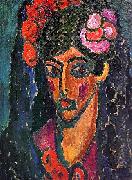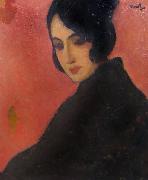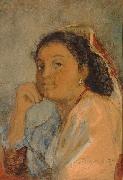Wholesale Oil Painting No Minimum |
|||||||||||
|
|
|||||||||||

|
|||||||||||
|
|
|
||||||||
Alexei Jawlensky1864-1941 Russian Alexei Jawlensky Galleries Alexej von Jawlensky was born in Torzhok, a town in the department of Tver, Russia, as the fifth child of Georgi von Jawlensky and his wife Alexandra (n??e Medwedewa). His family was aristocratic. At the age of ten he moved with his family to Moscow. After a few years of military training, he became interested in painting, visiting the Moscow World Exposition c. in 1880. In 1896 he moved to Munich where he studied in the private school of Anton Azbe. In Munich he met Wassily Kandinsky, and Marianne von Werefkin, other Russian artists and helped form the Neue Kunstlervereinigung M??nchen. His work in this period was lush and richly coloured, but later moved towards abstraction with a simplified and formulaic style in a search to find the spiritual. Alexej von Jawlensky. Abstract Head, c. 1928He died in Wiesbaden, Germany on 15 March 1941. |
||||||||
|
|
||||||||
Spanish Woman
Spanish Woman Painting ID:: 2061 |
1913
Lenbachhaus, Munich 1913 Lenbachhaus, Munich |
|||||||
|
|
||||||||
Nicolae Tonitza(Romanian pronunciation: [nikoˈla.e toˈnit͡sa]; April 13, 1886 - February 27, 1940) was a Romanian painter, engraver, lithographer, journalist and art critic. Drawing inspiration from Post-impressionism and Expressionism, he had a major role in introducing modernist guidelines to local art. Born in Bârlad, he left his home town in 1902 in order to attend the Iaşi National School of Fine Arts, where he had among his teachers Gheorghe Popovici and Emanoil Bardasare.The following year he visited Italy together with University of Bucharest students of archeology under the direction of Grigore Tocilescu.During that period, together with some of his fellow students, Tonitza painted the walls of Grozeşti church. In 1908 he left for Munich, where he attended the Royal Academy of Fine Arts; he began publishing political cartoons in Furnica, and contributing art criticism articles to Arta Română. Tonitza spent the following three years in Paris, where he visited artists' studios, and studied famous paintings.Although the young artist's creation would initially conform to the prevalent style, his gift for colour and his personal touch would eventually lead him towards experiment.Throughout his life, he remained committed to the Munich School, hailing its innovative style over the supposedly "obscure imitators of Matisse". |
||||||||
|
|
||||||||
|
|
Spanish Woman
Spanish Woman Painting ID:: 80818 |
oil on cardboard, 55 x 45 cm.
Date 1927-1928
cyf oil on cardboard, 55 x 45 cm. Date 1927-1928 cyf |
||||||
|
|
||||||||
Anders ZornSwedish 1860-1920 Swedish painter, etcher and sculptor. He was brought up by his grandparents at Mora. As he displayed a precocious talent for drawing he was admitted to the preparatory class of the Kungliga Akademi for de Fria Konsterna, Stockholm, at the age of 15. Dissatisfied with the outdated teaching and discipline of the Academy and encouraged by his early success as a painter of watercolour portraits and genre scenes (e.g. Old Woman from Mora, 1879; Mora, Zornmus.) Zorn left the Academy in 1881 to try to establish an international career. He later resided mainly in London but also travelled extensively in Italy, France, Spain, Algeria and the Balkans and visited Constantinople. However, he continued to spend most of his summers in Sweden. |
||||||||
|
|
||||||||
|
|
Spanish Woman
Spanish Woman Painting ID:: 95395 |
Date 1879(1879)
Medium watercolor
Dimensions 27 x 18 cm (10.6 x 7.1 in)
TTD Date 1879(1879) Medium watercolor Dimensions 27 x 18 cm (10.6 x 7.1 in) TTD |
||||||
|
|
||||||||
|
Anders Zorn Swedish 1860-1920 Swedish painter, etcher and sculptor. He was brought up by his grandparents at Mora. As he displayed a precocious talent for drawing he was admitted to the preparatory class of the Kungliga Akademi for de Fria Konsterna, Stockholm, at the age of 15. Dissatisfied with the outdated teaching and discipline of the Academy and encouraged by his early success as a painter of watercolour portraits and genre scenes (e.g. Old Woman from Mora, 1879; Mora, Zornmus.) Zorn left the Academy in 1881 to try to establish an international career. He later resided mainly in London but also travelled extensively in Italy, France, Spain, Algeria and the Balkans and visited Constantinople. However, he continued to spend most of his summers in Sweden. Spanish Woman Date 1879(1879) Medium watercolor Dimensions 27 x 18 cm (10.6 x 7.1 in) TTD |
||||||||
|
|
||||||||
|
Prev Next
|
||||||||
|
|
||||||||
|
Related Paintings to Anders Zorn :. |
||||||||
|
|
||||||||
|
CONTACT US |



